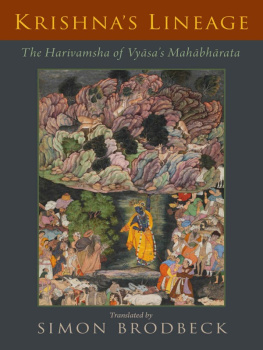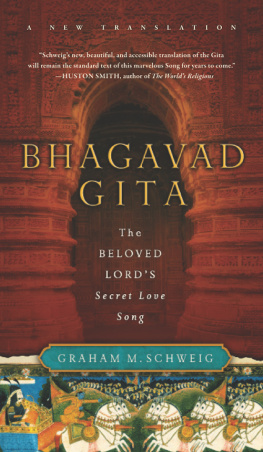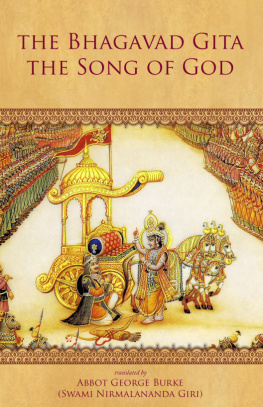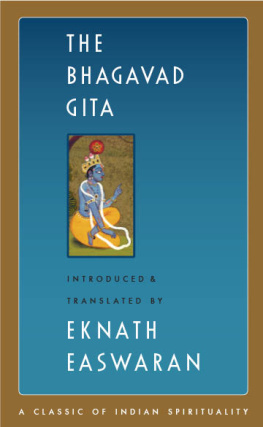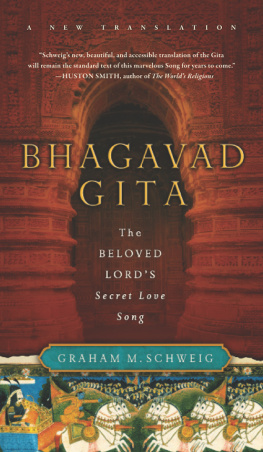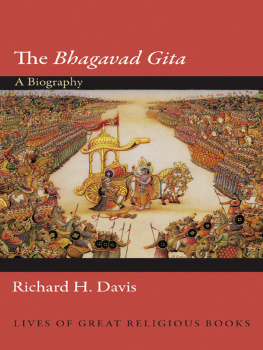Laurie L. Patton is Charles Howard Candler Professor of Early Indian Religions at Emory University. Her scholarly interests are in the interpretation of early Indian ritual and narrative, comparative mythology, literary theory in the study of religion and women and Hinduism in contemporary India. In addition to over forty articles in these fields, she is the author or editor of seven books:
(ed., with Edwin Bryant, 2005). Her book of poetry,
, was published by White Clouds Press in 2003.
Note on the Translation
I have tried to negotiate between the simplicity and accuracy of the Sanskrit language and the poetic, philosophical and religious vision which the
Gita expresses. With a more diverse audience in mind, it is important to emphasize the dialogical nature of the
Gita; such verbal exchange is a form of literary and artistic and even philosophical expression in many different cultures. Thus it seemed best to translate each section, called
adhyaya in Sanskrit, as Discourse. While
adhyaya is frequently translated as chapter, it can also mean a teaching or instruction that occurs between a teacher and a student.
Discourse seemed most appropriate because, in addition to delineating a section or part of a text, it implies a kind of conversation about a subject matter, as well as a teaching. I have opted for poetry over prose, and have tried to make every verse a poem in its own right, creating new associative possibilities in the mind of the reader. In addition, I have opted for eight-line rather than four-line verses, because first-time readers of the Gita might have an easier time if they encounter a single concept or image on each line, rather than several new concepts or images on each line. While I think it would sound somewhat contrived to the modern ear to mirror the strict metrical anushthubh or trishthubh metres of the Sanskrit, I also did not want to work entirely in free verse without restrictions. My query in translating was: What would be the contemporary cultural equivalent of the easygoing and flexible shloka in ancient India? And my answer was something like free verse, with a maximum number of eight syllables per line (and frequently far fewer), and a set number of eight lines. In this way, directness of imagery and brevity of expression are the means to preserve the compelling nature of the mythological subjects being treated in the poem.
My intention here is not to mysticize the Gita, and render it overly poetic in a way which lends itself too much to aesthetic or mystical concerns. In making each verse like a poem, I am aiming to reflect the proverbial or aphoristic nature of the text, in which shlokas are selected and quoted to comment on other texts, or on everyday situations. Second, my intention has been to focus on the simple poetic properties of the Sanskrit language. With all of the complexity of the theological, philosophical and sacrificial worlds during the post-Vedic period in which the Gita was probably composed, the text also utilizes the physical image. None of the older, more concrete resonances of the early Vedic world were replaced, but rather they were expanded upon with new, more abstract imagery hence the oscillation between philosophy and poetry. In this spirit, whenever possible, I have tried to give the flavour of a Sanskrit compound in all of its poetic specificity.
For example, in verse 11.29 the reader encounters the famous image of the warriors moving into Krishnas mouth like moths into a flame. Here, the word for moth is patanga (patam + ga), the flying-goer. One could simply translate as moth, but the poetic properties of the word for moth a flying-goer would be lost. And the larger image, not simply of moths moving into the mouth, but also of the speed of rushing in to be burned, should be preserved. So, I have translated, moths that fly to their full Third, I have also chosen to translate the epithets that Arjuna and Krishna use for each other within their conversation, such as Scorcher of the Enemy, or Mover of Men. Many scholars assume that these epithets are inserted for metrical purposes.
However, it is my view that the use of epithets gives the Gita a unique richness and texture. Indeed, epithets function like nicknames in the Gita, where Krishna and Arjuna engage in a kind of ironic exchange on the subject at hand. I have provided a list of epithets for both Krishna and Arjuna to make the text accessible and enjoyable for the first-time reader. In addition, particularly in the First Discourse, many different warriors from both Kaurava and Pandava sides of the war are named. In cases where the name of a warrior has particularly rich meaning, for the readers enjoyment I use the original Sanskrit name and translate that name in the verse itself. I also do this with the names of the conch-shell horns that are blown by the warriors.
It is my hope that these small decisions in translation and poetic construction will make for pleasurable reading. The challenge of the Gita should be in the ideas of the text, and yet readers should also be able to take delight in the aesthetics and imagery contained within its language. And so the samvada, both internal and external, should continue.
NOTE ON SANSKRIT PRONUNCIATION AND ENGLISH RENDERING
For accessibility for the first-time reader, Sanskrit terms are not written with diacritical markings in this translation, but in Anglicized form. Sanskrit has long vowels, as well as retroflex (also called cerebral) consonants (pronounced with the tongue at the roof of the mouth) and dental consonants (pronounced with the tongue near the teeth). These features can only be roughly reproduced in the Anglicized forms of the words.
For a full guide to Sanskrit pronunciation, see Sally J. Sutherland and Robert P. Goldmans Devav?pravsik: An Introduction to the Sanskrit Language, 3rd edition (Berkeley: Center for South Asian Studies, 1999). Most Sanskrit consonants are pronounced like their English counterparts. Sanskrit g is always pronounced hard, as in gull. And Sanskrit c is always pronounced like the ch in English chair.
Those consonants spelled with h after them (kh, gh, ch, jh, th, dh, ph, bh), such as the dh in Dhritarashtra, are called aspirated consonants. They are pronounced with a short burst of air right after the consonant: the difference between red and re


